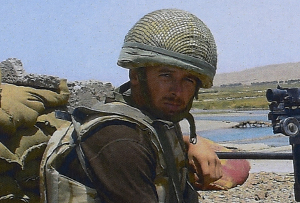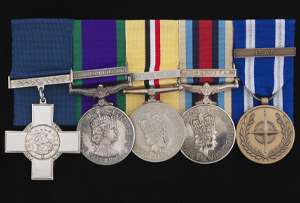Mark William Wright GC
Name: Mark William Wright
Conflict: Afghanistan
Gazetted: December 15, 2006
Service: Army
Place/date of birth: Edinburgh, Scotland/April 22, 1979
Rank when awarded GC (and later highest rank): Corporal
Date of bravery: September 6, 2006
London Gazette citation:
25087140 Corporal Mark William Wright. The Parachute Regiment (killed in action)
From July 2006, a fire support group of 3rd Battalion The Parachute Regiment, consisting of mortars, snipers, heavy machine guns and anti-tank weapons, held a high ridge feature to the south of the Kajaki Dam in the northern centre of Helmand Province. This group was tasked with defending the dam area from Taliban attack. On 6 September Lance Corporal Hale was ordered to lead a sniper patrol down the southern side of the ridge in an attempt to engage a group of Taliban fighters that had been reported to be operating on the principal highway to the east of the ridge. Three hundred metres from his main position Lance Corporal Hale stepped on a mine, which blew off one of his legs. Seeing the mine-strike from the top of the ridge, Corporal Wright gathered a number of personnel and rushed down the slope to give assistance. Fully aware of the risk of entering a minefield in which a casualty had already occurred, Corporal Wright made a conscious decision to enter the mined area knowing he faced a significant risk of initiating a mine. On arriving alongside the injured Lance Corporal Hale, Corporal Wright immediately took command of the incident and directed two qualified medical orderlies to take over the treatment of Lance Corporal Hale. Conscious of the dangers of operating in a minefield, Corporal Wright ordered all unnecessary personnel to safety and then began organising the casualty evacuation. Realising that Lance Corporal Hale was likely to bleed to death if they attempted to move him back up the steep slope, Corporal Wright called for a helicopter and ordered a route to be cleared through the minefield to a possible landing site. Corporal Pearson undertook the task, but stepped on a mine and suffered a traumatic amputation of his left leg when moving back across the route he thought he had cleared. Corporal Wright at once moved to Corporal Pearson and began rendering assistance until one of the medical orderlies could take over. In doing so, he again took the risk of setting off another mine. Once again Corporal Wright ordered all non-essential personnel to stay out of the minefield and began sending a further situation report to his headquarters. He also ensured that urgently required additional medical items were passed down the ridge to treat those wounded in the minefield. Shortly afterwards a Chinook CH47 helicopter landed to an offset position from the minefield, but as Corporal Wright stood up to begin making his way to the helicopter he initiated a third mine sustaining serious injuries to his left shoulder and chest area and also to his face. This mine also caused chest injuries to one of the two medical personnel. The remaining medical orderly set about treating Corporal Wright, but was himself wounded by a fourth mine blast which blew off the leg of a soldier treating Corporal Pearson. This blast caused further injury to both Corporal Wright and Corporal Pearson and the medical orderly. After the fourth mine blast there were now seven casualties still in the minefield, three of whom had lost limbs. All of those injured, including Corporal Wright, were in very real danger of bleeding to death. Medical supplies were becoming exhausted and initial hope of rescue had disappeared as the CH47 helicopter had had to abort its mission.
Despite this horrific situation, his own very serious injuries and the precarious situation of the others in the minefield, Corporal Wright still strove to exercise control of the situation. He did this despite being in great pain and fully aware that he was in danger of bleeding to death. He gave his identification number and ordered those other injured personnel to do so as well in order to assist with their treatment once evacuated. Until eventually evacuated by an American aircraft equipped with a winch, Corporal Wright remained conscious for the majority of the time that help took to arrive. During this period he continued to shout encouragement to those around him and several survivors subsequently paid tribute to the contribution this made to maintaining morale and calm amongst so many wounded men. Regrettably, Corporal Wright died of his wounds on the helicopter during the transit flight to the field dressing station.
There is absolutely no doubt that Corporal Wright entered the minefield to assist Lance Corporal Hale in the full knowledge of the dangerous situation. He had the option to wait for a mine clearance team to arrive, but decided to take action immediately, realising that conducting a full mine clearance to reach Lance Corporal Hale would take too long and he was likely to die before it was completed. When further casualties occurred he again ordered others to safety, but continued to move around the minefield to control the situation. In doing so he suffered mortal injury but still continued to demonstrate command presence that was so vital to eventually ensuring that all casualties and members of the rescue party were evacuated from the horrific situation. It is notable that from the time of responding to the first mine strike, Corporal Wright spent three and a half hours in the minefield and that for a significant amount of that time he himself was very seriously wounded and in great pain. His outstandingly courageous actions and leadership were an inspiration to all those around him during an extremely precarious situation. His complete disregard for his own safety while doing everything possible to retain control of the situation and to save lives constitutes an act of the greatest gallantry.
Click here to see full Gazette entry.
Other decorations: N/A
Place/date of death: South of Kajaki Dam, Helmand Province, Afghanistan/ September 6, 2006
Grave/memorials: Headstone in Memorial Garden and name in Book of Remembrance, Morton Hall Crematorium, Edinburgh; Mark Wright Project Centre established at Dalkeith, Midlothian, in November 2009; Mark Wright House, Army Recovery Centre, Erskine’s Home, Gilmerton, Edinburgh; conference room at Permanent Joint HQ, Northwood, Middlesex
Origin of VC to the Lord Ashcroft collection: Purchased privately, 2018
Current location of VC: Displayed on rotation at The Lord Ashcroft Gallery: Extraordinary Heroes exhibition, Imperial War Museum

